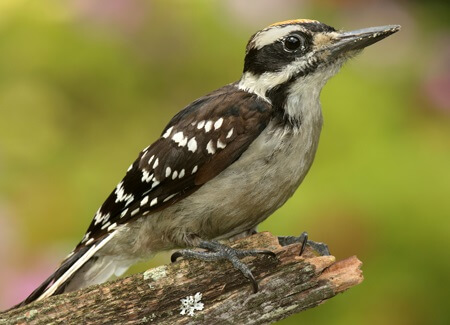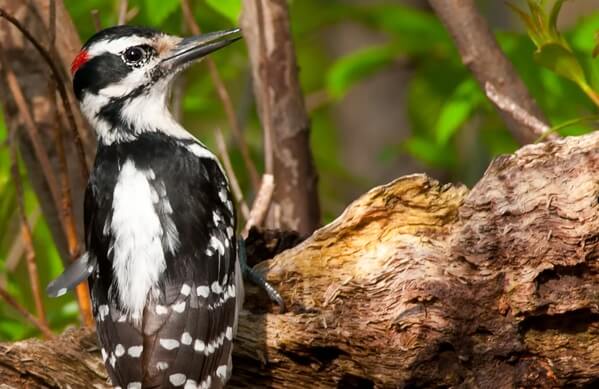 The Hairy Woodpecker gets its name from the long, thread-like white feathers that run down the middle of its black back. This species looks very much like the Downy Woodpecker, but has a heftier bill. It's also larger, measuring 9 to 10 inches in length — about the same size as Brazil's rare Kaempfer's Woodpecker.
The Hairy Woodpecker gets its name from the long, thread-like white feathers that run down the middle of its black back. This species looks very much like the Downy Woodpecker, but has a heftier bill. It's also larger, measuring 9 to 10 inches in length — about the same size as Brazil's rare Kaempfer's Woodpecker.
Ornithologist Arthur Cleveland Bent noted in his Life Histories of North American Birds (published 1919-1968), "The Hairy Woodpecker is a much shier, more retiring bird than the confiding little downy; it is also more active and noisier; it usually will not allow such close approach but will dodge around the trunk of a tree or fly away, if an intruder comes too near, bounding through the air in a series of graceful dips and rebounds."
As befits its bigger size, the Hairy Woodpecker favors more extensive woods with larger trees; this species may even visit well-wooded suburban backyards and parks. This woodpecker can often be located by its explosive “peek” call — incongruously, a higher-pitched call than that of the smaller Downy Woodpecker.
Hairy Woodpecker populations are declining as a result of habitat loss, particularly of older forests. Like Eastern Bluebird, it competes with introduced species such as European Starling for nest holes.
Drumming Up a Mate
The Hairy Woodpecker is one of the most geographically variable bird species in North America, with 17 subspecies currently recognized. These subspecies show regional differences in coloration, patterning, and size.
Male and female Hairy Woodpeckers look almost exactly alike, but (as with the Downy) the male signals its gender with a red patch on the back of its head. Since woodpeckers don't sing to attract mates, they use non-vocal means such as drumming to attract potential partners and lay claim to territories.
Sign up for ABC's eNews to learn how you can help protect birds
Noted ornithologist Edward Howe Forbush described this noisy courtship perfectly in 1927:
"On bright March days this bird begins to practice what is either a love song, a challenge, a call to its mate, or all combined. This is no vocal music but instead a loud drumming on some resonant dead tree, branch, or pole. This long roll or tattoo is louder than that of the Downy Woodpecker, not quite so long, and with a slightly greater interval between each succeeding stroke. It takes a practiced ear, however, to distinguish between the drumming of these two species."
Hairy Woodpeckers are cavity nesters, like Brazil's tiny Tawny Piculet and the rest of the woodpecker tribe. Both sexes excavate the nesting cavity, incubate the clutch of three to six eggs, and feed the young.

Juvenile Hairy Woodpecker by Steve Byland, Shutterstock
Avian Lumberjacks
From the Red-headed to the Blond-crested, woodpeckers are expert climbers. The Hairy is no exception, with strong feet and claws that allow it to cling to tree trunks and branches in almost any position.
Specialized stiff tail feathers act as a prop while the bird hammers away at trees in search of insects, which make up more than 75 percent of its diet. This species especially favors wood-boring insects and their larvae and is often found in areas infested with bark beetles.
The rest of the Hairy Woodpecker's diet is made up of fruits, seeds, and nuts; it has even been seen drinking sap from wells made in the bark by sapsuckers (such as Williamson's Sapsucker). Hairy Woodpeckers have even been known to follow Pileated Woodpeckers, taking insects that the larger birds excavated and missed.
Conserving Hairy Woodpecker Habitat
Although the Hairy Woodpecker is relatively common and widespread, it is threatened by forest loss, particularly of mature forests with larger trees.
ABC works with a wide variety of partners in forested landscapes across the United States, ranging from Appalachia to the Pacific Northwest. Our projects help sustain and conserve habitat used by Hairy Woodpecker and many other bird species, from Cerulean Warbler to Flammulated Owl.
Donate to support ABC's conservation mission!



















































